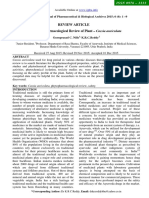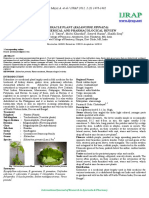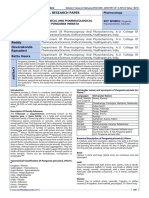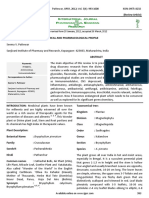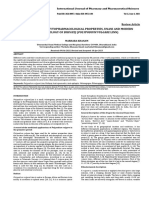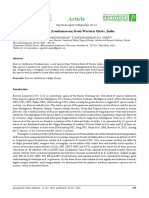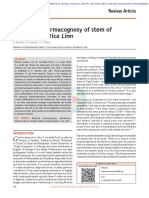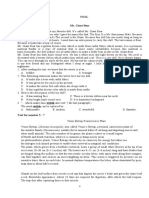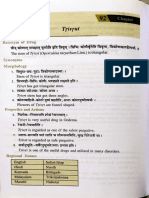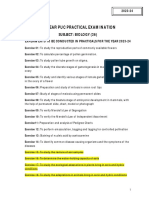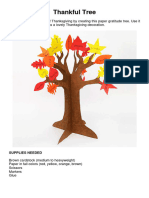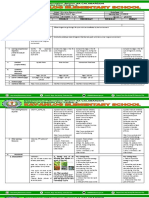Indo-Global Research Journal of Pharmaceutical Sciences July-Sept 2013 - Vol. 3 - Issue.3
Indo-Global Research Journal of Pharmaceutical Sciences July-Sept 2013 - Vol. 3 - Issue.3
Uploaded by
Rani SujithCopyright:
Available Formats
Indo-Global Research Journal of Pharmaceutical Sciences July-Sept 2013 - Vol. 3 - Issue.3
Indo-Global Research Journal of Pharmaceutical Sciences July-Sept 2013 - Vol. 3 - Issue.3
Uploaded by
Rani SujithOriginal Title
Copyright
Available Formats
Share this document
Did you find this document useful?
Is this content inappropriate?
Copyright:
Available Formats
Indo-Global Research Journal of Pharmaceutical Sciences July-Sept 2013 - Vol. 3 - Issue.3
Indo-Global Research Journal of Pharmaceutical Sciences July-Sept 2013 - Vol. 3 - Issue.3
Uploaded by
Rani SujithCopyright:
Available Formats
INDO-GLOBAL RESEARCH LIBRARY
Indo-Global Research Journal of Pharmaceutical Sciences
July-Sept 2013 | Vol. 3 |Issue.3
Available online www.igrlinfo.com
Review Article ISSN: 2249-4189
NERVILIA ARAGOANA GAUD, A TERRESTRIAL ORCHID
ELIZABETH THOMAS1, ANEESH T. P1, DELLA GRACE THOMAS2
1 Amrita School of Pharmacy, Amrita Vishwa Vidyapeetham University, AIMS Health Sciences Campus, Kochi, Kerala, India.
2 Triveni Institute of Pharmacy, Kechery, Thrissur
Email: aneeshtp@aims.amrita.edu
ABSTRACT
Medicinal plants have had a crucial role in human culture and civilization. Plants have been directly used as medicines by a majority of cultures
around the world. Many of the modern medicines are produced indirectly from medicinal plants. Nervilia aragoana Gaudichaud, a terrestrial
orchid belongs to the family Orchidaceae is an important medicinal plant used among the tribes of India. N. aragoana is found mainly in hilly
areas especially the monsoonal rain forests of India. The parts of the plant mainly used are underground rhizome and leaf. The plant contains
alkaloids, flavonoids, triterpenoids, mineral elements, amino acids. Tubers and leaves are the official parts used as drug. T he plant is cooling,
diuretic and tonic, useful in uropathy, lithiasis, colic, agalactia, mental instability, haemoptysis etc. The tuber is used as a medicine for the
treatment of epilepsy, in urinary complaints, diarrhoea and asthma.
Key words: Nervilia aragoana, medicinal plants, Orchidaceae, traditional medicine
INTRODUCTION
Man has the knowledge about the plants and their medicinal So the plant is mainly found in India, Malaysia, northern Thailand,
properties from ancient period itself. Medicinal plants have Laos, Burma, Indonesia and New Guinea [7]. It is a well-known
played a major and important role in the development of human herb in the traditional medicine and has been used to treat
culture also. Even the higher mammals are well aware of some urinary complaints, mental instability, epileptic fits, diarrhoea,
curative purpose of the medicinal plants. India is a country asthma, cough, vomiting [8]. The plant consists of flavanoids,
known for numerous varieties of species of medicinal plants and cyanogenic glycosides, tannins, alkaloids, flavanoids, steroids/
is used by a major percent of world’s population. These are used triterpenoids [5, 6, 9]. Figure 1. shows the plant N. aragoana, the
not only in developing countries but also in the developed figure 2. shows the underground rhizome of the plant and the
countries where most modern medicines are used. India is figure 3. shows the flower of the plant.
blessed with the ancient medical system called Ayurveda and also
with very valuable books like Charaka samhita, Sushruta samhita,
Ashtanga Hridayam, Ashtanga Sangraha etc [1]. Plants can be
directly used as medicine and also many of the modern medicines
are produced indirectly from medicinal plants. Due to the
increase in awareness of the side effects adverse drug reactions
and the cost factor of modern system of medicine the interest in
traditional medicine have been increased.
N. aragoana GAUD is a terrestrial orchid belongs to the family
Orchidaceae. The parts of the plant mainly used are underground
rhizome and leaf [2]. The French botanist Charles Gaudichaud Figure 1. The plant Nervilia aragoana
Beaupre (1789-1854) gave the plant the name N. aragoana in
1829 [3]. The Orchidaceae family is considered to be the most
evolved species and the largest and highly advanced botanical
family in higher plants [4]. It is a widely distributed
monocotyledonous family with a large number of terrestrial,
saprophytic and epiphytic species. The family comprises more
than 30,000 species. About 1300 species with 140 genera of
orchid species are found in India [5].
N. aragoana is a terrestrial orchid found mainly in hilly humid
shady areas of dense forests in India [2, 6]. It is mostly found in
the forest areas of Darjeeling Himalaya growing at elevations of
Figure 2. The rhizome of Nervilia aragoana
400-1000 m [4]. It is also reported to be found in McIlwraith
Range in Queensland, Australia, from 0–150 metres altitude.
INDO-GLOBAL RESEARCH LIBRARY
www.igrlinfo.com
4
SYNONYMS OF N.ARAGOANA [10, 11, 12, 13] cm. It is broadly ovate to orbicular, and is 15-18 nerved [9].
Aplostellis aragoana (Gaudichaud-Beaupré) Ridley Inflorescence is few to many flowered and is about 30 cm tall. It
Aplostellis flabelliformis (Lindley) Ridley has an average of 5 flowers [9, 20]. Flowers are attractive
Epipactis carinata Roxburgh yellowish green in colour, drooping, shortly and pedicelate [9].
Nervilia carinata (Roxburgh) Schlechter Bracts are small, decurved, linear and lanceolate [9, 17]. The
Nervilia flabelliformis (Lindley) Tang & Wang sepals are oblanceolate, subacute, spread widely and lanceolate
Nervilia scottii (Reichenbach f.) Schlechter and have 20-25 mm length, 2-4 mm width [9, 11, 17]. Petals are
Nervilia tibetensis Rolfe similar to sepals and are narrowed down to the base and have
Nervilia yaeyamensis Hayata about 18-24 mm length, 2-2.5 mm width [17, 9]. The lip is white
Pogonia carinata (Roxburgh) Lindley or yellowish white with purplish lines and is narrowed, three
lobed and incurved at base. When expanded it has 15-18 mm
Pogonia gracilis Blume; Pogonia flabelliformis Lindley
length, 8-10 mm width near the middle, side lobes are triangular
Pogonia nervilia Blume
and has 3 mm length, midlobe is ovate to ovate-triangular having
Pogonia scottii Reichenbach f.
6-8 mm length [17, 6, 21]. The anther is short and cucullate and is
1.8- 2 mm tall. The stigma is semiorbicular and concave. Leaf
Table 1 : Common names of N. aragoana in Indian languages
appears usually after the withering of inflorescence [9]. Ovary 2-5
are as follows [12, 14, 15, 16, 17 and 18]
mm long, drooping, winged on ridges. Reproduction is usually by
vegetative manner, through underground stolons [2].
LANGUAGE COMMON NAME
Sanskrit Padmacharini / Padmacarini
Hindi Sthalapadma, Sthalakamal
Tall Shield Orchid, Aragoa like Nervilia,
English One Leaf Orchid
Orilathamarai
Tamil
Malayalam Orilathamara, Kalthamara, Nilathamara
Table 2. Classification [10, 12, 13]
KINGDOM PLANTAE Figure 3. The flower of Nervilia aragoana
Division Angiospermae PHARMACOANATOMY
Root
Class Monocotyledoneae The primary vascular structure of the root is pentarch. A
Order Asparagales comparatively large pith is present. Large cells are packed in a
single layer which constitutes Epiblema and the cortex is
Family Orchidaceae parenchymatous in which large cells are present and with small
intercellular spaces [9].
Subfamily Epidendroideae
Tuber
Tribe Gastrodieae Epidermis is single layered which is characterised by thin cuticle
Sub tribe Nervilliinae and unicellular trichomes. The ground tissue is parenchymatous
which is characterized by thin walled polygonal cells, harbouring
Genus Nervilia microbial colonies. A few small and scattered vascular bundles
are present [9].
Species aragoana GAUD
Phytochemical Screening
Bhogaonkar et al reported the phytochemical profile of N.
Table 3. Ayurvedic Medicinal Properties [2] aragoana by using the common identification tests. From the
phytochemical studies it is relieved that the plant N. aragoana
Rasa Tikta, Katu contains alkaloids, flavonoids, triterpenoids, mineral elements,
amino acids. The leaf of the plant is reported to contain
Guna Lakhu flavonoids, cyanogenic glycosides, terpenoids and tannins [9, 5].
Virya Seeta Beena and Radhakrishnan also have reported various TLC
fingerprints developed by the methanolic extract of N. aragoana
by trying different mobile system combinations and spray
reagents. The same paper also reported the Phytochemical
MORPHOLOGY analysis of aqueous extract of rhizome and leaves by different
N. aragoana is a herb which grows up to 15 cm in height [2]. The chemical tests. Analysis of aqueous rhizome extract showed the
plant is perennating by underground subglobose white tubers presence of flavanoids, glycosides, sterols and tannins. And the
with 2-3 cm diameter and 3-4 noded [8, 17]. Leaf is single, analysis of aqueous leaf extract showed the presence of
petiolate, appearing after flowers, with chordate base and wavy flavanoids, glycosides and tannins. They also reported presence
margins [2, 9, 19]. Leaf is usually 6-15 cm long, more or less of alkaloids by phytochemical analysis. The fluorescent studies of
rounded, apiculate at apex and cordate at base [17]. Leaves are the aqueous extract revealed the presence of chromophore
bright green in colour with prominent radiating veins [11]. constituents. And also they reported a specific TLC fingerprint
Petiole is long having 8-20 cm length [17]. Lamina is 9-12 × 8-11 with seven characteristic bands with fluorescence [22].
INDO-GLOBAL RESEARCH LIBRARY
www.igrlinfo.com
5
CH3
Tohru et al have reported different fatty acids in various extracts
of the dried whole plant. The ether extract of the whole plant was CH3
analyzed by GC-MS after methylation and reported to contain H3C
fatty acids such as methyl palmitate, methyl lenolate and methyl H
lenolinate. The neutral fraction of ethereal extract was reported CH3 CH3
to contain phytol, a mixed glyceride, two crystalline substances
which constitute a mixture of triterpene alcohols. This mixture CH3
was identified to contain cycloeucalenol acetate,
dihydrocyclonervilol acetate, dihydrocycloeucalenol acetate
(after acetylation) and two triterpenes cyclonervilol and
cyclohomonervilol by GC-MS analysis [23]. The plant is also HO
reported to contain 24- Isopropenyl cholesterol [24]. The
methanolic extract was reported to contain a large amount of Stigmasterol
precipitate L-norleucine by direct comparison with an authentic
sample by means of amino acid analysis. The soluble fraction of
methanolic extract was reported to contain the same as that of USES
ethereal extract [23]. The plant N. aragoana has got many uses in traditional medicine
and also in folk medicine. Tubers and leaves are the official parts
The chemical structures of the identified constituents present in used as drug [2]. The plant is cooling, diuretic and tonic; useful in
extracts of N. aragoana reported by Tohru Kikuchi is given below uropathy, lithiasis, colic, agalactia, mental instability,
[23]: haemoptysis etc [9]. The tuber is used as a medicine for the
treatment of epilepsy, in urinary complaints, diarrhoea and
CH3 (CH2)3 (CH2 CH=CH)2 (CH2)7 COOCH3 asthma [2, 22]. The fresh tuber which is cleaned properly is
Methyl linolate believed to control hunger and thirst [9, 25]. The plant is also
used for vata, pitta, mental disease, hemiplegia, cough and
vomiting [2].
CH3 (CH2CH=CH)3 CH7 COOCH3
Methyl linolenate This plant is being used as a medicine among many tribes of
India. The tribals have developed their own pharmacopoeia of
their traditional knowledge about the medicinal uses of plants by
CH3 CH3 CH3 CH3 trial and error method. The plant is being used by the Bhilla tribe
of Maharashtra. The tuber paste is applied on forehead till relief
during headache [26]. It is reported that the tubers of the plant
are being used for the treatment of blood dysentery by the tribal
rehabitants of Amarkantak plateau, Madhya Pradesh, India. For
the treatment of blood dysentery the tribal people are using the
tuber of the plant N. aragoana and are reported to be
H3C OH
administered as paste which is mixed with 5 ml honey and taken
orally twice a day for five days [27]. The leaves of the plant can be
Phytol used as a protective medicine after child birth [25, 22, 28]. The
decoction of the leaves of this plant is used as a tonic for women
and the tuber is used as a galactogogue [9].
CH2
Antioxidant Activity
CH3
H3C It has been found that the ethyl acetate extract of the whole plant
N. aragoana exhibits good antioxidant activity. The antioxidant
CH3 activity was evaluated by TLC-DPPH method assay and also DPPH
CH3
radical, superoxide, nitric oxide, H2O2 scavenging, and reducing
power activities were carried out. The acute toxicity studies were
CH3 carried out using albino rats and have shown no morality rate.
CH3 Total phenols were reported to be 340 mg/g extract of Gallic acid
O
equivalents [29].
O
CH3 Antifungal Activity
Ethyl acetate extract of the whole plant N. aragoana was reported
Cycloeucalenol acetate to produce good anti fungal activity. The minimum inhibitory
concentration is reported as Saccharomyces cerevisiae (1.4
CH3 mg/mL) > Aspergillus niger (1.2 mg/mL) > Aspergillus fumigatus
H3C
CH3
(0.95 mg/mL) > Cryptococcus neoformans (0.75 mg/mL) [29].
CH3 CH3 CONCLUSION
N. aragoana is a beautiful and interesting terrestrial orchid found
CH3
in the monsoon tropical forests in India. It is a plant which is
H3C nearly jeopardised in many states in Kerala. And is also restricted
O the exporting of plant by the Government of India. So it is very
CH3
important to protect the plant within its nstural environment. N.
aragoana consists of alkaloids, flavonoids, triterpenoids, mineral
Dihydroeucalenol acetate elements, amino acids glycosides tannins etc. The plant is used as
INDO-GLOBAL RESEARCH LIBRARY
www.igrlinfo.com
6
16. Flowers of India.
diuretic and tonic; useful in uropathy, lithiasis, colic, agalactia, http://www.flowersofindia.net
mental instability, haemoptysis, epilepsy, in urinary complaints, 17. Flora of Taiwan, http://www.efloras.org
diarrhoea and asthma, vata, pitta, mental disease, hemiplegia, 18. R.Vasudevan Nair, Controversial Drug Plants
cough and vomiting. The fresh tuber which is cleaned properly is Distributed by Orient Longman Private Limited, Page
believed to control hunger and thirst. So far a very few research 147.
has been carried out on the plant N. aragoana which is known to 19. V. V. Sivarajan, Indira Balachandran, Ayurvedic Drugs
have potential benefits amoung tribes. It is suggested that a and Their Plant Sources, Oxford and IBH Publishing,
thorough investigation on the particular plant will provide with 1994, 336-337
important scientific findings for the benefit of the mankind is 20. Orchidaceae Malaysiana 2.
required. http://orchidaceaemalaysiana2.blogspot.in
21. Gunnar Seidenfaden, Jeffrey James Wood, The orchids of
REFERENCES peninsular Malaysia and Singapore, Dec 1992 by Oslen
1. The ayurvedic institute. &Oslen, 137.
http://www.ayurveda.com/index.html 22. Beena C., Radhakrishnan V.V., Bioprospecting on the
2. Ayurvedic medicinal plants endangered medicinal plant nervilia aragoana gaud,
http://ayurvedicmedicinalplants.com Journal of Progressive Agriculture, 2011, 2: 1,
3. Charles Gaudichaud-Beaupré, Botanical Cabinet. 23. Tohru Kikuchi, Shigetoshi Kadota, Sayaka Hanagaki,
http://botanicalcabinet.com Hisashi Suehara, Tsuneo Namba, Chun-Ching Linn and
4. Rajendra Yonzone, D. Lama, R. B. Bhujel and Samuel Woei Song Kan, Studies on the Constituents of
Rai., Orchid species diversity of Darjeeling Himalaya of Orchidaceous Plants. 1. Constituents of Nervilia
India, International Journal of Pharmacy and Life purpurea SCHLECHTER and Nervilia aragoana
Sciences, 2012, 3: 3, 1533-1550. GAUD.Pharmaceutical Society of Japan, Chem. Pharm.
5. M. Maridass, M. I. Zahir and G. Raju, Phytochemical Bull, 1981, 29: 7, 2073-2078.
Survey of Orchids in the Tirunelveli Hills of South 24. Shigetoshi Kadota, Takehiko Shima and Tohru Kikochi,
India, Ethnobotanical Leaflets, 2008, 12, 705-12. Studies on the Constituents of Orchidaceous Plants. VII.
6. Envis centre on medicinal plants. the C24 Stereochemistry of Cyclohomonervilol and 24-
http://envis.frlht.org Isopropenylcholesterol, Nonconventional Sidechain
7. Jones, L. David, A Complete Guide to Native Orchids of and Triterpene and Sterol, from Nervilia purpurea
Australia Including the Island Territories, Frenchs Schlechter. Chem. Pharm. Bull, 1987, 35: 1, 200-210.
Forest, Second edition, 2006, 281. 25. NeMedPlant A Database of medicinal plants from
8. Nervilia aragoana - Medicinal Plants Research: northeast india
Kottakkal. http://bif.uohyd.ac.in/nemedplant/search/Rightsearch
http://cmpravs.com Result.php?g=Nagaland.
9. P. Y. Bhogaonkar and V. D. Devankar, Pharmacognostic 26. S. Y. Kamble, S. R. Patil, P. S. Sawant, Sangita Sawant, S.
Studies on Padmacarini, Aryavaidyan, Nov. 2006- Jan. G. Pawar and E. A. Singh, Studies on Plants used in
2007, 20, No. 2, 74-79. traditional medicine by Bhilla tribe of Maharashtra,
10. Prof. Summer's Web Garden Indian Journal of Traditional Knowledge, July 2010, 9:
http://www7a.biglobe.ne.jp/~flower_world/Orchids/N 3, 591-598.
ervilia%20aragoana.htm 27. Arjun Prasad Tiwari, Bhavana Joshi and A. A. Ansari,
11. Australian tropical rainforest orchids. Less Known Ethnomedicinal Uses of Some Orchids by
http://www.anbg.gov.au the Tribal inhabitants of Amarkantak Plateau Madhya
12. Catalogue of life, china 2012 annual checklist. Pradesh, India. Nature and Science 2012, 10: 12, 33-37.
http://www.catalogueoflife.org 28. P. Ramesh, Renganathan and C. Mani, Medicinal uses of
13. Discover Life. some epiphytic and terrestrial Orchids, Int. J. Cur. Tr.
http://www.discoverlife.org Res., 2012, 1: 1, 13-16
14. Toxicology Center.com 29. K. H. Reddy, P. V. Sharma, O. V. Reddy, A comparative in
http://www.toxicologycentre.com vitro study on antifungal and antioxidant activities of
15. Cook Islands biodiversity and natural heritage. Nervilia aragoana and Atlantia monophylla, Pharm. Biol.,
http://cookislands.bishopmuseum.org 2010 May, 48: 5, 595-602.
INDO-GLOBAL RESEARCH LIBRARY
www.igrlinfo.com
7
You might also like
- The Scarlet Ibis TextDocument7 pagesThe Scarlet Ibis Textapi-26325597264% (14)
- 1154 PDF PDFDocument7 pages1154 PDF PDFJoe PidisNo ratings yet
- Phytochemical and Pharmacological Properties Of: Entada Phaseoloides (L.) : A ReviewDocument9 pagesPhytochemical and Pharmacological Properties Of: Entada Phaseoloides (L.) : A ReviewKathakoli duttaNo ratings yet
- 181-Article Text-231-1-10-20210305Document6 pages181-Article Text-231-1-10-20210305R. INo ratings yet
- Study and Formulation of Sapistan As Expectorant SyrupDocument10 pagesStudy and Formulation of Sapistan As Expectorant SyrupKhan FalakNo ratings yet
- E Flora-SVC Final 2021Document46 pagesE Flora-SVC Final 2021ChahatNo ratings yet
- An Update On LEUCAS ASPERADocument6 pagesAn Update On LEUCAS ASPERASuprabuddha KunduNo ratings yet
- The Miracle Plant Kalanchoe Pinnata A PhytochemicaDocument6 pagesThe Miracle Plant Kalanchoe Pinnata A PhytochemicaAboli GhateNo ratings yet
- 00 Botanical Pharmacognsoy of Beejband - 1 Rumex Maritimus PDFDocument3 pages00 Botanical Pharmacognsoy of Beejband - 1 Rumex Maritimus PDFKannanNo ratings yet
- Pharmacognostic Study of Cassia Tora L A ReviewDocument4 pagesPharmacognostic Study of Cassia Tora L A ReviewAvantikaNo ratings yet
- The Miracle Plant (Kalanchoe Pinnata) A Pyhtochemical ReviewDocument5 pagesThe Miracle Plant (Kalanchoe Pinnata) A Pyhtochemical ReviewJohn100% (1)
- 8 HaritakiDocument20 pages8 HaritakiManoj100% (1)
- Phytochemical and Pharmacological Activities of Pergularia Tomentosa L. - A ReviewDocument8 pagesPhytochemical and Pharmacological Activities of Pergularia Tomentosa L. - A ReviewBaru Chandrasekhar RaoNo ratings yet
- Millingtonia Hortensis LinnDocument3 pagesMillingtonia Hortensis LinnBiswajit Dey100% (2)
- Review of Cassia AuriculataDocument9 pagesReview of Cassia AuriculataGURUPRASAD NILLENo ratings yet
- A Review On Euphorbia Neriifolia Plant: April 2017Document7 pagesA Review On Euphorbia Neriifolia Plant: April 2017Eunice ArutaNo ratings yet
- Psidium Guajava PDFDocument16 pagesPsidium Guajava PDFLyla WahyuniNo ratings yet
- 3Document8 pages3Karina Winda BessufiNo ratings yet
- Momordica Charantia Linn. (Karela) : Nature's Silent HealerDocument7 pagesMomordica Charantia Linn. (Karela) : Nature's Silent Healerdaud faisalNo ratings yet
- The Miracle Plant Kalanchoe Pinnata A PhytochemicaDocument6 pagesThe Miracle Plant Kalanchoe Pinnata A PhytochemicaEvgyrt NesralNo ratings yet
- Rev Saraca IndicaDocument5 pagesRev Saraca IndicaMSKCNo ratings yet
- Insulin Plant - A Review On Insulin Plant Costus Igneus NakDocument6 pagesInsulin Plant - A Review On Insulin Plant Costus Igneus NakAmabel JameroNo ratings yet
- Cocor Bebek PDFDocument5 pagesCocor Bebek PDFAgung PribadiNo ratings yet
- 4-Vol.-7-Issue-1-Jan-2016-IJPSR-RE-1738-Paper-4Document11 pages4-Vol.-7-Issue-1-Jan-2016-IJPSR-RE-1738-Paper-4unanimous.eduNo ratings yet
- 4 Vol. 7 Issue 1 Jan 2016 IJPSR RE 1738 Paper 4Document11 pages4 Vol. 7 Issue 1 Jan 2016 IJPSR RE 1738 Paper 4Yusuf Almalik SaputraNo ratings yet
- Dissertation. - Shreya MoulickDocument23 pagesDissertation. - Shreya MoulickShreya MoulickNo ratings yet
- Original Research Paper: PharmacologyDocument4 pagesOriginal Research Paper: PharmacologyDr. Ramadevi DevarakondaNo ratings yet
- 11-Review On Some Plants of Indian Traditional Medicine WithDocument21 pages11-Review On Some Plants of Indian Traditional Medicine WithNafhyraJunetNo ratings yet
- A Review On Aegle Marmelos A Potential Medicinal TDocument6 pagesA Review On Aegle Marmelos A Potential Medicinal TsaravabioNo ratings yet
- Useful Plant Species With Toxic SubstanceDocument15 pagesUseful Plant Species With Toxic Substancepandaypira100% (1)
- Morinda Citrifolia Is A Tree in The Coffee Family, Rubiaceae. Its Native Range Extends ThroughDocument8 pagesMorinda Citrifolia Is A Tree in The Coffee Family, Rubiaceae. Its Native Range Extends ThroughEdgar Senense Cariaga100% (1)
- Tamarindus Indica Extent of Explored PotentialDocument11 pagesTamarindus Indica Extent of Explored PotentialCitra Ayu ApriliaNo ratings yet
- Review Article: Pharmacognosy, Phytochemistry and Pharmacology of Abrus Precatorius Leaf: A ReviewDocument6 pagesReview Article: Pharmacognosy, Phytochemistry and Pharmacology of Abrus Precatorius Leaf: A ReviewwalneyNo ratings yet
- KalanchoeDocument1 pageKalanchoeAnonymous iOYpj92No ratings yet
- OrchidDocument17 pagesOrchidDibya Prakash PattnaikNo ratings yet
- Tinospora Cordifolia and Pterocarpus Marsupium: An Anti-Diabetic Plant With MultipurposeDocument11 pagesTinospora Cordifolia and Pterocarpus Marsupium: An Anti-Diabetic Plant With MultipurposeInternational Journal of Innovative Science and Research TechnologyNo ratings yet
- Dissertation FINALDocument24 pagesDissertation FINALShreya MoulickNo ratings yet
- Phys Ali San Gulat A ScienceDocument6 pagesPhys Ali San Gulat A ScienceIftri mellaniNo ratings yet
- Ayurvedic Plants and InformationDocument3 pagesAyurvedic Plants and InformationAsif ShaikhNo ratings yet
- Research Article Research Article Research ArticleDocument6 pagesResearch Article Research Article Research Articleorang biasaNo ratings yet
- Moringa OleiferaDocument13 pagesMoringa OleiferaEmcee WaterNo ratings yet
- A Review On Phytochemical and Pharmacological Properties of Phyllanthus Amarus Schum. and Thonn.-2018Document10 pagesA Review On Phytochemical and Pharmacological Properties of Phyllanthus Amarus Schum. and Thonn.-2018Dhivya SubramaniNo ratings yet
- Randia SpinosaDocument5 pagesRandia SpinosaamritaryaaligarghNo ratings yet
- Phytochemical and Pharmacological Studies On Polyalthia LongifoliaDocument7 pagesPhytochemical and Pharmacological Studies On Polyalthia LongifoliaDr. Ramadevi DevarakondaNo ratings yet
- Diversity of Ornamental Climbers in Kattathurai Panchayath, Kanyakumari District, Tamil Nadu, IndiaDocument3 pagesDiversity of Ornamental Climbers in Kattathurai Panchayath, Kanyakumari District, Tamil Nadu, IndiaAngel Eduardo Moreno AlboresNo ratings yet
- A Review On The Phytopharmacological ProDocument5 pagesA Review On The Phytopharmacological ProMaryem SafdarNo ratings yet
- Artemisia Dracunculus L.) (Review) : Biological Characteristics and Useful Properties of Tarragon (Document6 pagesArtemisia Dracunculus L.) (Review) : Biological Characteristics and Useful Properties of Tarragon (Akarat SivaphongthongchaiNo ratings yet
- Atlas (B10&12)Document73 pagesAtlas (B10&12)Audrie Allyson GabalesNo ratings yet
- Philippine Medicinal Plants IllustratedDocument86 pagesPhilippine Medicinal Plants IllustratedRaiden Gyver100% (1)
- Numerical Taxonomic Studies On Coleus Forskohlii Collected From Different Geographical Regions of IndiaDocument4 pagesNumerical Taxonomic Studies On Coleus Forskohlii Collected From Different Geographical Regions of IndiaAdityaNo ratings yet
- Exacum Idukkianum Published Oct 2016Document5 pagesExacum Idukkianum Published Oct 2016PERUMAL RAVICHANDRANNo ratings yet
- Literature Review On Curcuma CaesiaDocument4 pagesLiterature Review On Curcuma CaesiaPratik KanchanNo ratings yet
- Taxonomy and Traditional Medicinal Uses of Apocynaceae (Dogbane) Family of Rajshahi District, BangladeshDocument9 pagesTaxonomy and Traditional Medicinal Uses of Apocynaceae (Dogbane) Family of Rajshahi District, BangladeshTang KouyNo ratings yet
- Clerodendrum Serratum: A Clinical ApproachDocument5 pagesClerodendrum Serratum: A Clinical ApproachMasamune SoraNo ratings yet
- 169 Jipbsv3i109 PDFDocument7 pages169 Jipbsv3i109 PDFsandeepNo ratings yet
- Available Online Through: International Journal of Pharmaceutical Archive-2 (3), 2013Document10 pagesAvailable Online Through: International Journal of Pharmaceutical Archive-2 (3), 2013Beladiena Citra Siregar100% (1)
- BillaDocument5 pagesBillaZeeshan AfzalNo ratings yet
- 796 PDF PDFDocument5 pages796 PDF PDFIcha YulianiNo ratings yet
- Ethno Botanical Study of Hiptage BenghalensisDocument10 pagesEthno Botanical Study of Hiptage BenghalensisSasikala RajendranNo ratings yet
- 00 Botanical Pharmacognosy of Stem of Gmelina Asiatica PDFDocument4 pages00 Botanical Pharmacognosy of Stem of Gmelina Asiatica PDFKannanNo ratings yet
- Biology Practical FileDocument22 pagesBiology Practical Filesahilsoni000101No ratings yet
- Jackfruit PPT Full PDFDocument71 pagesJackfruit PPT Full PDFNurul Hidayati KhasanahNo ratings yet
- Botany PracticalDocument1 pageBotany PracticalAbhisek SarkarNo ratings yet
- GNB (Gerakan Non Blok) PDFDocument5 pagesGNB (Gerakan Non Blok) PDFDealova EmanuelNo ratings yet
- Soal Bahasa Inggris Minggu Ke 2Document4 pagesSoal Bahasa Inggris Minggu Ke 2zaharNo ratings yet
- The Art of Bonsai - Diane RelfDocument4 pagesThe Art of Bonsai - Diane Relfdirnthelord100% (1)
- SRIFPDocument3 pagesSRIFPdrlite0895No ratings yet
- Dispoyrous Eboneum TreeDocument13 pagesDispoyrous Eboneum TreeMani VannanNo ratings yet
- Change The Active To Passive If PossibleDocument3 pagesChange The Active To Passive If Possiblerahmatul qadri002No ratings yet
- Transport in Cells 2 QP - PAPER 2 GOOD QUESTION PDFDocument14 pagesTransport in Cells 2 QP - PAPER 2 GOOD QUESTION PDFAlexia Micallef GattNo ratings yet
- Impact of PGR On Fruit Crops.Document78 pagesImpact of PGR On Fruit Crops.Aravinda samy SaravananNo ratings yet
- Anatomi Batang Monokotil PDFDocument22 pagesAnatomi Batang Monokotil PDFRifkah Aj. AnjaniNo ratings yet
- Angiosperm or GymnospermDocument2 pagesAngiosperm or Gymnospermtuti_ron_007100% (1)
- TAXON - 2017 - Azani - A New Subfamily Classification of The Leguminosae Based On A Taxonomically Comprehensive PhylogenyDocument34 pagesTAXON - 2017 - Azani - A New Subfamily Classification of The Leguminosae Based On A Taxonomically Comprehensive Phylogenysjtham12No ratings yet
- Whenever He Tired He Used To Eat Delicious Apples of The TreeDocument3 pagesWhenever He Tired He Used To Eat Delicious Apples of The TreeOmprakash ChandrakarNo ratings yet
- Lecture2 PsilotumDocument19 pagesLecture2 PsilotumEng:Ahmed-salem-farhatNo ratings yet
- TrivritDocument5 pagesTrivritChauhan BapuNo ratings yet
- Science Class 5 PaperDocument3 pagesScience Class 5 Paperjawadkhantanoli71No ratings yet
- Ap Bio Lab 3Document9 pagesAp Bio Lab 3MoniqueRajbhandariNo ratings yet
- The National List of Threatened Philippine Plants and Their Categories PDF - PDFDocument33 pagesThe National List of Threatened Philippine Plants and Their Categories PDF - PDFMaria Fe Navigar LegurpaNo ratings yet
- Biology CompleteDocument72 pagesBiology Completebansalpriyanshi74No ratings yet
- 2PUCBIOLOGY RlsDocument6 pages2PUCBIOLOGY RlsChetan GuggariNo ratings yet
- WOOD As A BUILDING MATERIAL 2Document9 pagesWOOD As A BUILDING MATERIAL 2Jays Tioxon IIINo ratings yet
- Homologous and Analogous Organs Class Xii PracticalDocument4 pagesHomologous and Analogous Organs Class Xii PracticalAnushree100% (4)
- f3 Biology Simplified Notes SPDocument41 pagesf3 Biology Simplified Notes SPmicah isaboke100% (3)
- 3D Cardboard Tree 2Document9 pages3D Cardboard Tree 2SYLVIENo ratings yet
- PAT 301 - Rice Leaf SmutDocument8 pagesPAT 301 - Rice Leaf SmutBhuvanesh NagamaniNo ratings yet
- DLL - Science 4 - Q2 - W5Document14 pagesDLL - Science 4 - Q2 - W5Mary Grace AgnoNo ratings yet
- Public Places Worksheet Public Places WorksheetDocument2 pagesPublic Places Worksheet Public Places WorksheetHALIM PERDANANo ratings yet














